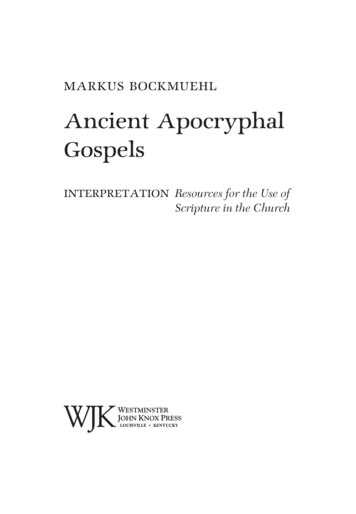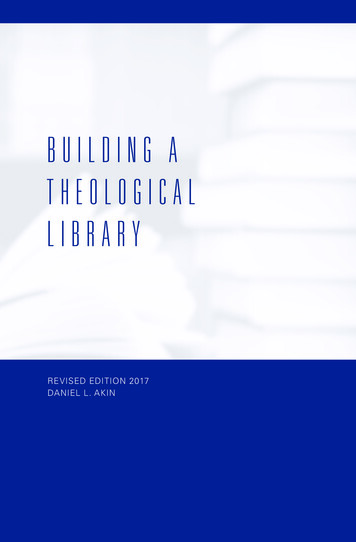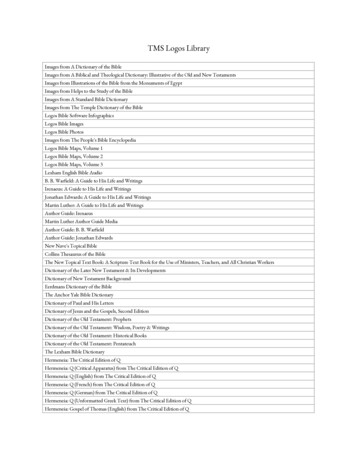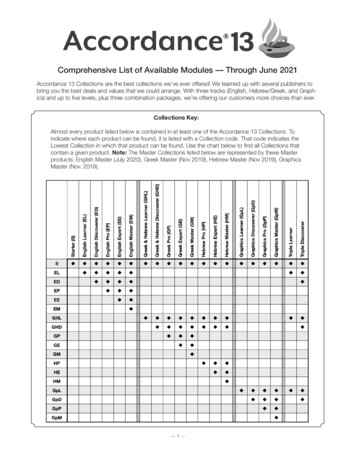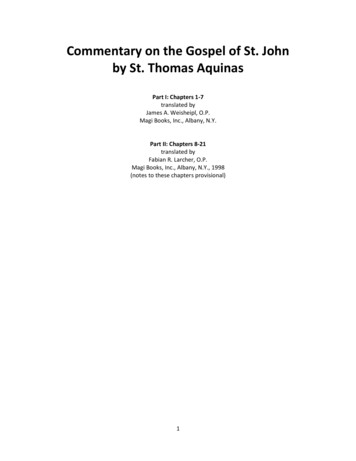
Transcription
Commentary on the Gospel of St. Johnby St. Thomas AquinasPart I: Chapters 1-7translated byJames A. Weisheipl, O.P.Magi Books, Inc., Albany, N.Y.Part II: Chapters 8-21translated byFabian R. Larcher, O.P.Magi Books, Inc., Albany, N.Y., 1998(notes to these chapters provisional)1
INTRODUCTIONSt. Thomas’ commentary on the Gospel of St. John is unique among his many writings on SacredScripture. It is the work of a master theologian, delivered at the University of Paris, then the intellectualcenter in Christendom, when Thomas was at the height of his fame and apostolic zeal for souls. Afourteenth-century list of Thomas’ writings notes that this commentary is a reportatio by Reginald ofPiperno and adds “better than which none can be found.” Footnote A reportatio is a verbal report of anactual lecture taken down by a scribe or student in the course of actual delivery. In this case the scribewas the faithful Friar Reginald of Piperno, who had been the “constant companion,” or socius, for thelast fifteen years of Thomas’ short but busy life. The Italian Province of Dominicans wisely providedThomas with this kind of personal secretary and general factotum after he returned from Paris as aMaster in Sacred Theology in 1260.A reportatio is not exactly a dictation in our sense of the term; it is more like a student’s notebook inshorthand containing basically the gist of what is being said, but usually with varying numbers of verbalomissions and inaccuracies. But this commentary is more than a mere scribal report. It was in fact“corrected” by Thomas himself—if we are to believe Tolomeo of Lucca, one of Thomas’ earlybiographers and confreres—before the commentary went into circulation through copies made by hand,the customary mode of publication before the era of the printing press. More than that: according toBernard Gui, another confrere and early biographer, Thomas himself wrote out in full the commentaryon the first five chapters of John (and hence this section ought to be considered an authentic expositio,or authoritative version), while the rest of it survived in the hand of Reginald, corrected by Thomas.This commentary was very popular in the Middle Ages, and it ranks among the best of Thomas’ work asa master theologian and saintly man of faith. It was read not only by theologians searching for the truth,but also by preachers and pious men and women desiring solid food for meditation and fervent prayer.Scattered throughout the world there still exist thirty-three complete and thirteen incompletemanuscript copies of this work, attesting to its considerable popularity before the age of printing.Innumerable copies of this work have no doubt been lost or destroyed in the tumult of centuriesfollowing the Middle Ages.This detailed commentary is St. Thomas’ personal response to the Word of God Incarnate as describedin the sublime words of John “the Divine.” For St. Thomas, the God of Abraham, Isaac, and Jacob spoketo his chosen people through the mouth of prophets in the long course of salvation history, “But whenthe appointed time came, God sent his Son, born of a woman, born a subject of the Law, to redeem thesubjects of the Law and to enable us to be adopted as sons” (Gal 4:4-5). This Incarnate Son, Jesus Christ,is the total manifestation of the Father, the Eternal Word made flesh. There is nothing left unsaid in theWord; the Father’s love is complete in the love the Son bears for the Father and for us. Christ’s wholelife, his passion, death, and resurrection, are the praise and glory of the Father “through the working ofthe Holy Spirit.” “You must believe me when I say that I am in the Father and the Father is in me” (Jn14:11). “Whatever you ask for in my name I will do, so that the Father may be glorified in the Son” (Jn14:13). Christ’s “food” was to do the will of his Father in all things, thus glorifying the Father in Jesus.One of St. Thomas’ basic theological principles is that everything Jesus Christ did and said was for ourinstruction and imitation. Thus the sanctity of our lives is the on-going praise and glory of the Father,through the Son, by the working of the Holy Spirit. The very being of the Father is the unqualifiedaffirmation of love for the Son and for us, in the Son. “God is love” (1 Jn 4:8). This love elicits from us an2
unreserved affirmation of love for God and neighbor, by which God is glorified and resplendent in us.The whole of our happiness is this eternal “glory” in tasting and seeing that the Lord is good (see Ps34:8). This commentary is St. Thomas’ tasting and seeing the goodness of Jesus, the Word Incarnate,embodied in the tender words of St. John, the “beloved disciple,” who leaned on the breast of the Saviorat the Last Supper.Thomas brought to his writing of this commentary on John all the resources at his disposal—which wereconsiderable—especially the riches of the whole Patristic teaching of the “Saints” (the sancti Doctores),the wealth of a living tradition in the Roman Church contained in its teaching, laws, liturgy, and the livingSpirit, as well as fidelity to the infallible norms of the Holy See.In an address to students and professors of the “Angelicum” (now the Pontifical University of St. Thomasin Rome) given on January 14, 1958, Pope Pius XII extolled the virtues of its patron, the Angelic Doctor,who serves as a divinely inspired guide in both philosophy and theology. Footnote Pope Pius spokeespecially of St. Thomas’ own studies as a norm for every student of the religious disciplines. Just as St.Thomas diligently explored and studied the Bible as the font and life-spring of all theological studies, sotoo should the modern student find in biblical studies the source of his theological development. As St.Thomas himself assures us, “[sacred doctrine] uses the authority of the canonical Scriptures properlyand of necessity in its investigations. for our faith is founded on the Revelation made to the Apostlesand Prophets, who wrote the canonical books, but not on revelation (if such there be) made to otherteachers.” Footnote In this conviction Thomas developed all his own theology. That is to say, the“complement” to Thomas’ speculations and synthesis are to be found in his commentaries on the booksof the Old and New Testaments, especially those on the Epistles of St. Paul.In the opinion of those most expert to judge, Thomas’ commentaries on Scripture “shine with suchsolidity, subtlety, and precision that they can be numbered among his greatest theological works,” andare to be esteemed as such. “Wherefore, if anyone should neglect them, he is scarcely to be said toclearly and fully enjoy a familiarity and knowledge of the holy Angelic Doctor.” The significant fact is notthat Pius XII emphasized the importance of studying Thomas’ biblical commentaries to Dominicans, whohad made their special prerogative the teaching of “speculative Thomistic theology” and the pursuit ofcontemplative prayer. The significant fact is that Pius XII expressed these sentiments shortly before hisdeath and fifteen years after one of his most important encyclicals, Divino afflante spiritu (30 Sept.1943), the basic charter of all Catholic biblical studies in our day, leading to the Dogmatic Constitutionon Divine Revelation, Dei verbum, of the Second Vatican Council (18 Nov. 1965). In other words, theenormous advances of modern biblical studies do not automatically nullify the importance of St.Thomas’ commentaries on the Sacred Text.St. Thomas’ commentaries on the Sacred Text are typically medieval, that is, they lack the unction,colloquialism, and engaging informality of Patristic commentaries (which were largely homilies), and thetechnical and sometimes journalistic resources of modern commentaries, explanations, andparaphrases. In other words, it is easier to read St. Augustine’s commentary on John than it is to read St.Thomas’ or that of any other medieval writer addressing students in the “schools” of Paris andelsewhere. The big difference is between Patristic and Monastic commentaries, which were largelyhomiletic, pastoral, personal, and mystical, on the one hand, and Scholastic commentaries aimed atteaching students in the university or studium the literal meaning of the text. The style of medievalScholastic commentaries is rather formal, literal, student-orientated and bookish. This style often makessuch commentaries difficult for a modem reader to follow, and to some extent hinders him fromderiving the greatest benefit for his mind and heart. At first glance such a “commentary”—with its3
definitions, divisions, arguments footnotes and concern for the orthodox meaning of the sacredmessage—may seem like searching for a needle in a haystack. But in the case of Thomas’ commentariesthe reader may be confident that his efforts at discovering that needle will prove to be bothintellectually and spiritually rewarding; once discovered, it will be valued as “the pearl of great price”(Mt 13:46).In this introduction I hope to show the historical context of this particular commentary and to indicatesome aids to a fruitful study of it.First of all, this work is a biblical commentary by a master in a medieval university. In the Middle Ages,the Bible and the Bible alone was the official basis for the teaching of theology by fully qualified mastersin the major universities of Europe. In fact, one could say with some justification that the ultimate goalof all medieval education was an understanding of the Bible for those who pursued the full course in theFaculty of Theology. Such an understanding was the nature of sacred theology (fides quaerensintellectum, “faith seeking understanding”). It was the source of all preaching of the Word of God, and itwas the inexhaustible font of living water for the spiritual life. In order to reach such a lofty goal, muchpreparation was required. First, tools had to be acquired as a means of such study. This was the role of agood liberal arts education and the acquisition of philosophy, “the handmaid of theology.” The study ofthe liberal arts and the acquisition of philosophy were functions of the Arts Faculty in the university orstudium. Approximately eight years were devoted by medieval students to acquiring these tools—roughly equivalent to our four years of high school and four years of college. After the full course hadbeen completed in “the humanities,” the young man, generally in his mid-twenties, would begin hisstudy of the Sacred Text, having already heard many sermons in Church and having received muchinstruction at home. His study of the Sacred Text began with listening and reading.In the Middle Ages, a personal copy of the Bible was relatively rare, certainly outside university circles.Every copy of the Bible was written out by hand on parchment, a writing surface made from carefullytreated skins of sheep. Such a copy was extremely expensive and hard to come by. Although everystudent of theology tried desperately to obtain a personal copy, most people had to rely on hearing theWord read to them and recollecting from memory the actual words of the Bible. For that reason thebeginner in theology would listen to older students and the master (professor). One of the olderstudents, the bachelor of theology, read aloud and paraphrased a particular book of the Bible. Thisbachelor was called a “Cursor Biblicus,” a “runner through” the actual words of the Bible, who did this toacquaint himself and his hearers with the inspired words.A splendid example of the work of such a “runner” is St. Thomas’ commentary on Isaiah; it is the work ofa cursor and not that of a master. Only a master could expound the text with authority and confidence;the bachelor merely skimmed through it as a runner would skim over the course in a race. A higherranking bachelor devoted his energies mainly to explaining the official theological handbook, theSentences of Peter Lombard (d. 1160). These Sentences were a systematic collection of Patristicteachings, arranged in four books following the order of the Apostles’ Creed. This bachelor was calledthe bachalarius Sententiarum, a “Bachelor of the Sentences. “After listening to others for about fouryears, the young student of theology would himself become a bachelor and perform certain dutiesunder a particular master, his main professor of theology.Every university in the Middle Ages had a limited number of chairs, or professorships, for the masters tooccupy. At the time of St. Thomas, there were twelve chairs of theology at the University of Paris, theDominicans having two of them. Before occupying one of these chairs, the student had to have devoted4
many long years to study and actual discussions, or “disputations,” in the university, He had to be atleast thirty-five years old before meriting the title of “Master of the Sacred Page” and the right toexpound the Bible in an authoritative manner as a true theologian, professionally qualified.St. Thomas was twice professor of theology at Paris—a fact most unusual in itself. There were very fewsuch cases where a fully fledged master would return to his old chair, thus preventing a new masterfrom occupying it. But the intellectual, social, and religious climate in Paris at that time demanded thereturn of Thomas to the center of all theological learning in Europe. The new mendicant Orders (mainlyDominicans and Franciscans) were again being attacked by secular (i.e., diocesan) masters of theology,and their right to teach, preach, and beg was challenged by some of the most powerful voices in Europe.The center of this controversy Was the University of Paris, where the very existence of Dominicans andFranciscans was under fire. At the climax of this renewed attack, the second in the history of theDominican Order, St. Thomas was recalled to Paris by the Master General of the Dominican Order,Blessed John of Vercelli. Thomas arrived in Paris with his companion Reginald in the cold winter of 1269after the academic term had begun. Immediately Thomas took upon himself the duties of a master intheology, namely, lecturing on a carefully chosen book of the Bible, presiding at academic “disputations”and resolving the question under discussion, and preaching to the university crowd. At the same time,he was composing the Second Part of his Summa theologiae, which he had begun in Rome two yearsearlier, and dictating a number of literal commentaries on various works of Aristotle for young mastersin arts, that is, teachers in the Faculty of Arts, whose duty it was to expound the text of Aristotle. Duringthe two and a half years Thomas spent at Paris the second time, he successfully defended the rights ofmendicants to teach, preach, and flourish. During this same Parisian regency he lectured on the Gospelof St. John.These lectures on John would have been lost to posterity had not the faithful Reginald taken notes,which were later “corrected” by Thomas himself. The reason Thomas “corrected” Reginald’stranscription was that a wealthy secular (i.e., diocesan) student wanted a copy for himself. This studentwas Adenulf of Anagni, an Italian cleric, provost of Saint-Omer (since 1264), later master in theology(1282-85), and canon of Notre Dame Cathedral in Paris. Adenulf, a student of Thomas during the years1269-72, offered a considerable amount of money to have a professional scribe make a copy of thisremarkable commentary for himself. Without Adenulf’s enthusiasm and money, the “lectures”(lecturae) on John would have remained a simple report, or reportatio. If it had not been for Reginald,apparently, these lectures would have gone completely from history. But the fact is that we do have athand the acute mind of Thomas Aquinas, a master theologian and saint, on the Gospel of St. John. Thiscommentary reflects the mind of Thomas at its peak, but before he composed the Third Part of theSumma dealing with Christ, the Sacraments, and the Church. It is a scholastic analysis of St. John’sremarkable testimony of the Good News of Salvation, namely, that the Word became flesh, died for oursalvation, and is now risen from the dead to come again as our merciful judge.Earlier, at the request of his intimate friend Pope Urban IV, Thomas had compiled a continuous gloss onall four Gospels, which he had collated from the Latin and Greek Fathers of the Church. Frequently heeven instigated new translations of Greek sources, as he himself confessed in the prologue. Thiscontinuous gloss, popularly called the Catena Aurea, or “Golden Chain,” was not finished when Urbandied in 1264. But Thomas continued his labors on the gloss, which he completed in 1267 and dedicatedto Cardinal Annibaldo d’Annibaldi, Thomas’ close friend and former pupil at Paris. The intense labor onthe Gospel of John for the Catena molded the mind of Thomas in his personal understanding of theSacred Text of John. St. John’s Gospel is very difficult to understand. Unlike the Synoptic writers,Matthew, Mark, and Luke, St. John’s Gospel is a carefully devised presentation of his personal5
understanding of the sacred doctrine taught by Jesus, on whose breast he reclined at the Last Supper.John was always known as “the disciple whom Jesus loved.” For St. Thomas, John, the Son of Zebedee,the author of this Gospel, was a virgin, whose appropriate symbol is the eagle soaring in the heights ofcontemplation. Thomas’ detailed study of the Latin and Greek Fathers, needed to complete his Gloss onJohn, prepared him to shed his own light on the text when the opportune moment arrived. Thatmoment arrived when Thomas returned to Paris for the second time (1269-72) at the age of about fortyfour, full of strength and vigor.But his is a typical medieval commentary because, unlike Patristic, monastic, and modern commentarieson John, it utilizes certain techniques familiar to all in the Middle Ages, but strange to us today. First ofall, it is a theological commentary concerned with penetrating the literal sense of the words recorded,and seeing through the literal sense to the spiritual. The medieval university theologian was primarilyconcerned with the literal sense of scripture, that is, with the sacred message intended by the humanand divine author. It is therefore primarily concerned with “the theological teaching” of the Bible. St.Thomas did not have at his disposal the infinitely varied techniques of modern biblical scholarship. Heknew almost nothing about biblical and near-eastern languages, archeology, philology, comparativereligion, and the historical method. If he had, he would most certainly have used them. In the EncyclicalDivino afflante Spiritu (30 Sept. 1943), Pope Pius XII urged the importance of textual criticism, biblicaland oriental languages, archeology, profane and sacred history, as well as form criticism and thedemands of a sound historical method. Footnote He noted with the Angelic Doctor that “in Scripturedivine things are presented to us in the manner which is in common use amongst men.” Footnote TheBible is the Word of God in the words of men, and this manner of speaking in various ages to variouspeople must be carefully studied with all the auxiliary sciences. But even after all this has been tendedto, there is still “the theological doctrine” contained in the Sacred Books. The modem exegete shoulduse every means available to discover and explain “the literal sense and especially the theological. “Footnote It is this “theological sense” (sensus theologicus), expounded by St. Thomas in hiscommentary, that is most fruitful for our meditation, prayer, and preaching the Word of God today.The literal sense, as St. Thomas teaches, is the objective, formal, and direct meaning intended by thewords in the sacred and inspired text. Footnote The author of these words is both God and man, sincethe Bible is “the inspired Word of God.” Modem biblical techniques, of course, were unknown toThomas. All he had was his personal copy of the Latin Vulgate (which was not a critical edition), thefamiliar teaching of all the Latin and Greek Fathers known to him, his own prayerful reflection on thetext, and his native genius attentive to the Spirit of God and to the text. Among the human meansThomas had at his disposal were grammar, logic, and Aristotelian philosophy. The literal (or historical)sense was in principle the only basis of theological thought and discussion. The spiritual sense onlyenlarged, or extended, the basic literal sense. By “spiritual sense” we do not mean the pious, personal,private, and subjective sense a reader might derive from a prayerful reading of the text. Rather, the“spiritual sense” is the enlarged reality “intended” by person, place, or thing signified in the literal, aswhen the brazen serpent raised by Moses in the desert is taken to signify Christ’s crucifixion as thedivine means of healing mankind, or when the paschal lamb is taken to signify Christ who was sacrificedfor our sins. The “spiritual sense” is the enlarged sense “intended” by a given symbol in the plan ofdivine providence.Since only God as the author of all things can make one symbol significative of another reality, the Bibleis the only book that can contain a “spiritual sense” as it was understood by medieval theologians.Consequently only the sacred author himself can inform us of the existence of such a sense. We couldnever know that one reality is to be taken as a symbol of another reality unless the Sacred Author so6
informs us in the literal sense. For example, the author of the Book of Numbers (21:19) explains howMoses was directed to make a brazen “serpent” and set it up as a sign; whoever was bitten by one ofthe fiery serpents and “looked at the sign” that Moses had set up was saved from death. But it is John(3:14 15) who explains that “as Moses lifted up the serpent in the desert, so must the Son of man belifted up that whoever believes in him may not perish, but may have life everlasting.” The significance ofOld Testament texts is declared by the sacred writer when he explains Christ’s actions as being “infulfillment of the Scriptures.” Similarly St. Paul frequently reveals the “spiritual sense” of the Law andProphets by declaring the Christian fulfillment in Jesus.There were three kinds of spiritual sense recognized by medieval theologians: the allegorical, the moral,and the anagogical. Footnote When anything in the Old Testament was taken to signify something in theNew Testament, this sense was called allegorical. Under this sense would be included all those figures,persons, and events as symbolic of Jesus and his life and death on earth. When anything in the life ofJesus is taken as a model for our life, we call this the moral sense. Under this sense would be included allthose virtues presented to us for our imitation of Christ. When anything in the Scriptures is taken tosignify something in the eternal kingdom hereafter, for example, “the new Jerusalem,” we call this theanagogical sense. Thus the “spiritual sense” of a passage was taken to be an objective meaning intendedby the sacred author, the Holy Spirit. This, of course, presupposes that the authors of the NewTestament were inspired by the Holy Spirit.Whatever personal message one may derive from reading the Bible prayerfully and thoughtfully ispurely personal and beyond the science of theology as the study of God’s message to mankind. Thepersonal message is most significant for the reader, but this personal significance must be carefullycontrolled by objective theological norms such as the Christian faith, sacred doctrine, the constantteaching of the Church, and a prayerful listening to the Holy Spirit.The most difficult technique of medieval commentators for us to comprehend is the use of logic and the“scholastic method.” Aristotelian logic is the most significant technique contained in the scholasticmethod. The purpose of the scholastic method was to instill “scientific” knowledge through (1)definition, (2) division, and (3) demonstration, or demonstrative proof. These techniques (or modisciendi) were taken for granted by every medieval theologian as the best means of learning the truthabout anything. It was a method of teaching, the via docendi, which was an imitation of the “way ofdiscovery” (via inveniendi or inventionis). The goal of all education is truth. The goal of theologicaleducation is an understanding of the doctrines of revelation, the sacra doctrina. Footnote It is faithseeking understanding (fides quaerens intellectum), as St. Anselm puts it, The scholastic method, in asense, is artificial and humanly contrived by ineans of logic. In the Middle Ages the scholastic methodwas thought to be the best way of learning everything from A to Z. An example of this method oflearning is embedded in Thomas’ commentary on John’s Gospel. It cannot be eliminated. Therefore itdepends on us moderns to bend a little by trying to see through it, and not be put off by it. Always onewill find definitions, divisions, and proofs in all medieval commentaries, whether they be on Aristotle,Boethius, or the Bible.The Scholastics had a penchant for order; where none existed, one was imposed. Heeding the words ofAristotle that “it belongs to the wise man to order,” they thought the prerogative of a good teacher wasto order all things well, setting out the message, or truth to be conveyed, in an orderly and fitting way.Footnote This is why the first thing one notices when reading a medieval commentary is the division, orthe ordering of the whole into parts. The least one can perceive is a beginning, a middle, and an end. Butmore than not, one can usually perceive some orderly procedure in the middle.7
Modern biblical scholars usually see in, St. John’s Gospel a prologue (1:1-14), a middle (cc. 1-20), and anepilogue (c. 21). They then proceed to divide the middle into the Book of Signs (cc. 1-12) and the Book ofGlory (cc. 13-20). St. Thomas also divides the Gospel into roughly these two parts, but he considerschapter 12 as belonging to the Book of Glory, because the chapter opens “six days before Passover”with the anointing of the feet of Jesus for his burial (12:1 -11), continues on to the triumphal entry intoJerusalem (12:12-19), builds to the coming of the Greeks (12:20-22), and the long discourse of Jesus inwhich he cries out, “Father, glorify your name” (12:28). In any case, it is particularly in this second partthat Thomas had to use his ingenuity to resolve the discrepancies between John and the Synoptics. TheSynoptics compress the public life of Jesus into one year with the one tragic journey of Jesus up toJerusalem, where he is crucified and dies, to be raised up on the third day. John extends the public life ofJesus into three years with the final year ending in his passion, death, and resurrection. St. Thomas isvery much concerned with the literal, or historical, sense of the narrative, especially as concerns thepassion, death, and resurrection of the Lord. Throughout the whole exposition of the narrative, Thomasrelied heavily on the interpretation of the Fathers of the Church, both Latin and Greek. He quotes theauthority of St. Augustine 373 times, St. John Chrysostom 217 times, and Origen 95 times. It is anexposition that relies heavily on the tradition of the Church and on his own prayerful theologicalreflections.In the commentary on St. John’s Gospel, Thomas is concerned not only with the literal sense, which forhim is of Prime importance and concern, but also with the spiritual sense, as explained above. Morethan the other Evangelists, John reveals the “fulfillment of the Scriptures,” that is, concern with theprophecies and symbols of the Old Law. Christ’s own prophetic words and actions are seen by John to bea foreshadowing of the passion, death, and resurrection of the Lord by which we are all saved. Above all,for St. Thomas, John is the Evangelist of the divinity of Jesus, “the Word made flesh.” He says, “Whilethe other Evangelists treat principally of the mysteries of the humanity of Christ, John, especially andabove all, makes known the divinity of Christ in his Gospel” (Prologue). Thomas, following the lead of St.Jerome, thought that John wrote his Gospel after the other three Gospels had been written, in order torefute new heresies that had arisen concerning the divinity of Christ. Following Jerome, Thomas singledout the Ebionites (whose founder Thomas erroneously thought to have been “Ebion”)—and Cerinthus, aGnostic heretic who flourished around 100 A.D., as among those who denied the divinity of Christ. EvenSt. Irenaeus (Adv. haer., III, 11) asserts that St. John wrote his Gospel to refute Cerinthus. Thus, St.Thomas observes in his Prologue, while John did not pass over the mysteries of Christ’s humanity, heespecially conveys the divinity of Christ in his Gospel. In this commentary, therefore, Thomas repeatedlyrefutes the heresies of Apollinaris, Arius, the Arians, Ebionites, Eutyches, the Manichees, Nestorius,Pelagius, the Pelagians, and Sabellius - all of which plagued the Church in the first five centuries of itsexistence. For Thomas these heresies were not merely false doctrines irrelevant to the modemChristian, but vital guidelines to the purity of the Christian faith, the orthodox teaching of the livingChurch.Earlier in his career, Thomas had been asked by the archbishop of Palermo to write a short work thatcould be memorized, dealing with the articles of faith “from the Creed of the Fathers” (i.e., the Apostles’Creed) and also the basic errors concerning them; the archbishop apparently asked also for the samepresentation for all the sacraments of the Church. Footnote Thomas complied with this request in amost remarkable treatise in two parts: De articulis fidei and De ecclesiae sacramentis. Footnote Thewide popularity of this treatise is attested to by the 277 extant manuscripts of this work. The six articlespertaining to the divinity of Christ and the six pertaining to his humanity are set forth, and all the errorsc
embodied in the tender words of St. John, the "beloved disciple," who leaned on the breast of the Savior at the Last Supper. Thomas brought to his writing of this commentary on John all the resources at his disposal—which were considerable—especially the riches of the whole Patristic teaching of the "Saints" (the sancti Doctores),



